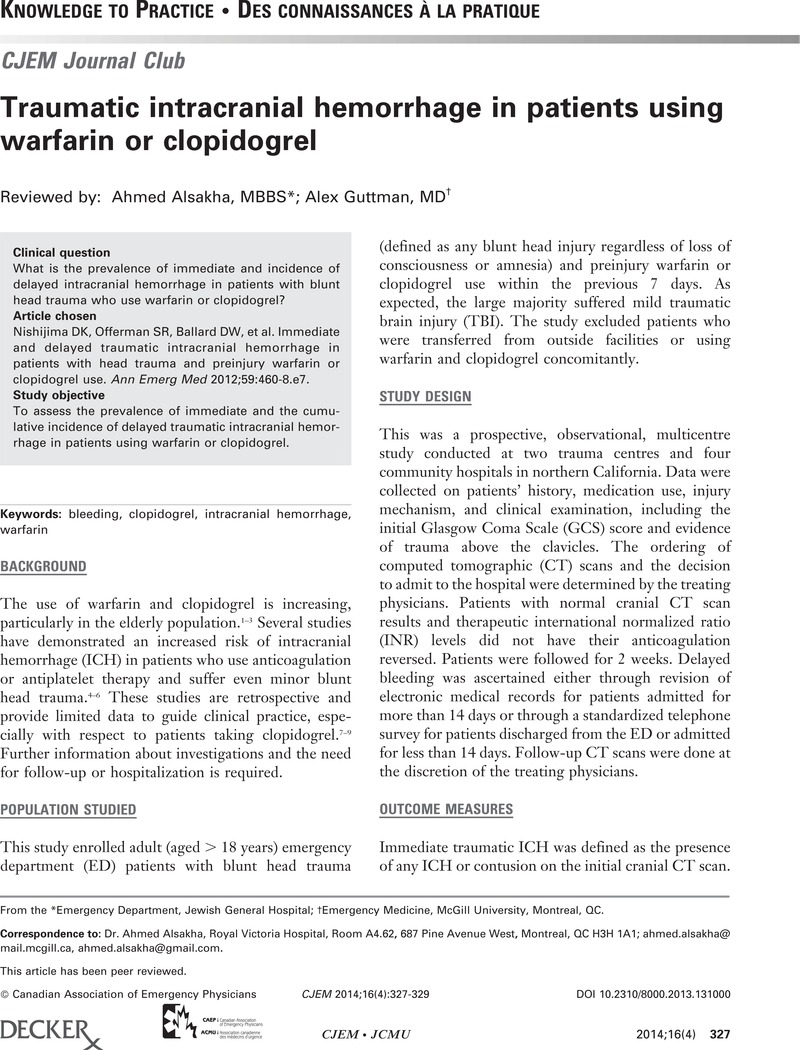No CrossRef data available.
Article contents
Traumatic intracranial hemorrhage in patients using warfarin or clopidogrel
Published online by Cambridge University Press: 04 March 2015
Abstract
An abstract is not available for this content so a preview has been provided. As you have access to this content, a full PDF is available via the ‘Save PDF’ action button.

- Type
- Knowledge To Practice • Des connaissances à la pratique
- Information
- Copyright
- Copyright © Canadian Association of Emergency Physicians 2014
References
REFERENCES
1.
Huhtakangas, J, Tetri, S, Juvela, S, et al. Effect of increased warfarin use on warfarin-related cerebral hemorrhage: alongitudinal population-based study. Stroke
2011;42:2431–5,doi:10.1161/STROKEAHA.111.615260.CrossRefGoogle Scholar
2.
Virjo, I, Makela, K, Aho, J, et al. Who receives anticoagulant treatment with warfarin and why? A population-based study in Finland. Scand J Prim Heath Care
2010;28:237–41, doi:10.3109/02813432.2010.514138.CrossRefGoogle Scholar
3.
Ostini, R, Hegney, D, Mackson, JM, et al. Why is the use of clopidogrel increasing rapidly in Australia? An exploration of geographical location, age, sex and cardiac stenting rates as possible influences on clopidogrel use. Pharmacoepidemiol Drug Saf
2008;17:1077–90, doi:10.1002/pds.1638.CrossRefGoogle Scholar
4.
Claudia, C, Claudia, R, Agostino, O, et al. Minor head injury in warfarinized patients: indicators of risk for intracranial hemorrhage. J Trauma
2011;70:906–9, doi:10.1097/TA.0b013e3182031ab7.Google ScholarPubMed
5.
Major, J, Reed, MJ.
A retrospective review of patients with head injury with coexistent anticoagulant and antiplatelet use admitted from a UK emergency department. Emerg Med J
2009;26:871–6, doi:10.1136/emj.2008.068643.CrossRefGoogle ScholarPubMed
6.
Brewer, ES, Reznikov, B, Liberman, RF, et al. Incidence and predictors of intracranial hemorrhage after minor head trauma in patients taking anticoagulant and antiplatelet medication. J Trauma
2011;70:E1–5, doi:10.1097/TA.0b013e3181e5e286.Google ScholarPubMed
7.
Cohen, DB, Rinker, C, Wilberger, JE.
Traumatic brain injury in anticoagulated patients. J Trauma
2006;60:553–7, doi:10.1097/01.ta.0000196542.54344.05.CrossRefGoogle ScholarPubMed
8.
Itshayek, E, Rosenthal, G, Fraifeld, S, et al. Delayed posttraumatic acute subdural hematoma in elderly patients on anticoagulation. Neurosurgery
2006;58:E851–6; discussion E851-6, doi:10.1227/01.NEU.0000209653.82936.96.CrossRefGoogle ScholarPubMed
9.
Reynolds, FD, Dietz, PA, Higgins, D, et al. Time to deterioration of the elderly, anticoagulated, minor head injury patient who presents without evidence of neurologic abnormality. J Trauma
2003;54:492–6, doi:10.1097/01.TA.0000051601.60556.FC.CrossRefGoogle ScholarPubMed
10.
Jagoda, AS, Bazarian, JJ, Bruns, JJ Jr, et al. Clinical policy: neuroimaging and decisionmaking in adult mild traumatic brain injury in the acute setting. Ann Emerg Med
2008;52:714–48, doi:10.1016/j.annemergmed.2008.08.021.CrossRefGoogle ScholarPubMed
11.
National Collaborative Centre for Acute Care and National Institute for Health and Clinical Excellence. Head injury: triage, assessment, investigation and early management of head injury in infants, children, and adults. Available at: (accessed February 24, 2012).Google Scholar
12.
Servadei, F, Teasdale, G, Merry, G.
Defining acute mild head injury in adults: a proposal based on prognostic factors, diagnosis, and management. J Neurotrauma
2001;18:657–64, doi:10.1089/089771501750357609.CrossRefGoogle ScholarPubMed
13.
Vos, PE, Battistin, L, Birbamer, G, et al. EFNS guideline on mild traumatic brain injury: report of an EFNS task force. Eur J Neurol
2002;9:207–19, doi:10.1046/j.1468-1331.2002.00407.x.CrossRefGoogle ScholarPubMed


